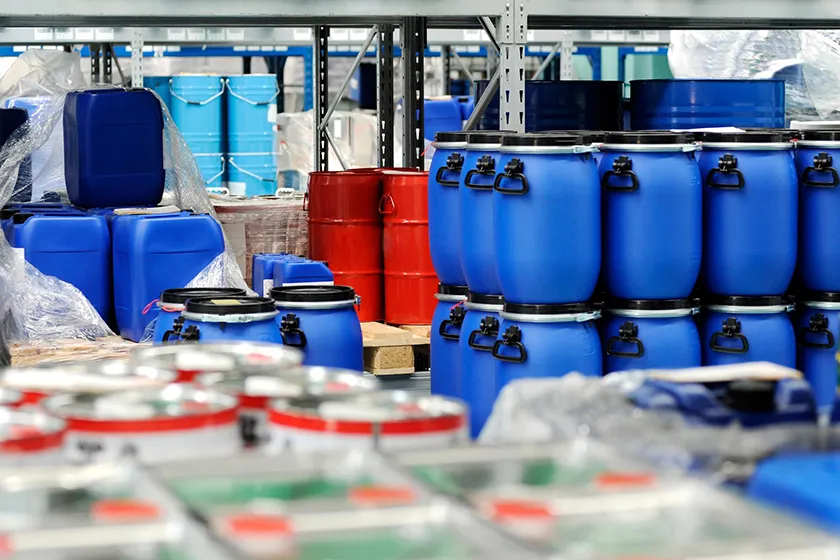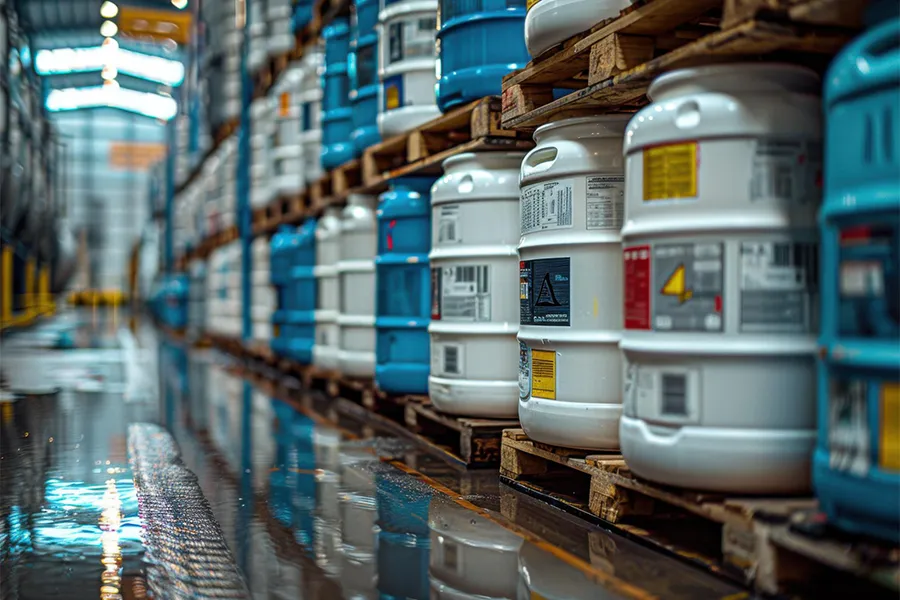Chemicals and toxins, due to their properties, may pose serious risks, including fire, explosion, poisoning, and environmental pollution. Therefore, proper and principled storage of these materials can prevent accidents and ensure overall safety in the field of chemical storage. In this article, while examining the characteristics, standards, and key points in the storage of chemicals and toxins, we have discussed international standards, the importance of observing safety principles, and optimizing chemical storage processes.

Features of a chemical storage warehouse
A chemical storage warehouse must have certain features and standards to prevent potential hazards and ensure employee safety. Below, we have mentioned some important features and standards in chemical storage:
- The first important feature is proper ventilation of the warehouse so that toxic gases and vapors that may be emitted from chemicals can be quickly removed from the warehouse. Also, fire protection systems must be in place in the warehouse, because many chemicals are flammable.
- Appropriate spacing between different materials, especially incompatible chemicals, prevents dangerous reactions. Also, accurate labeling and identification systems must be implemented in the warehouse so that all materials can be properly identified and tracked.
- Chemical warehouses must be equipped with safety systems such as fire extinguishers, fire extinguishers, and personal protective equipment.
- Temperature, humidity, and light control are essential for some chemicals, because inappropriate conditions can cause chemical changes and reactions.
- Continuous training of employees on proper storage and handling of chemicals and emergency preparedness are other essential features of a chemical storage facility.
- For storing chemicals, it is best to use cabinets with doors or shelves with edges that prevent the container from slipping and falling on the floor.
- The storage area for hazardous chemicals must have a lock and a chemical hazard sign must be installed at its entrance. Chemical safety sheets must also be available near the cupboard.
- The entrance and exit of the chemical storage facility must be slightly sloped to prevent liquid chemicals from settling outside the storage area.
Global Standards for Chemical Warehouse Layout
The layout of chemical warehouses should be in accordance with global standards to increase safety and protect the health of employees, and not worry about possible risks from storing hazardous materials.
NFPA Standard (Hazard Diamond)
The NFPA standard or hazard diamond is a standard system used to assess hazards in workplaces and determine safety methods, and relies more on fire hazards. The NFPA hazard diamond is a quadrangular symbol in which different colors indicate the display of warnings and specific hazards of chemicals. This diamond consists of four parts: the blue part (health hazard), the red part (flammability hazard), the yellow part (chemical reaction hazard), and the white part (special properties such as toxic substances or special hazards). According to this standard, chemicals with similar properties should be placed together to reduce the likelihood of a reaction.
OSHA Standard
OSHA standards that focus more on employee safety and working conditions in chemical storage, and according to this standard, the warehouse layout should be such that emergency exit routes, access to safety equipment such as fire extinguishers and fire extinguishing systems, and proper ventilation are provided. Also, according to the OSHA standard, chemicals should be classified based on their hazards and characteristics, and incompatible materials should be avoided from being stored together.
ISO 9001 Standard
The ISO 9001 international standard for chemical warehouses, while optimizing processes, helps organizations to carry out all stages of arrangement, storage, and movement of chemicals accurately and under control. According to this standard, recording and documentation of chemical information, delivery and usage history, and monitoring of the warehousing process are carried out accurately and regularly.
EPA (Environmental Protection Agency) Standards
EPA standards for chemical storage are designed to protect the environment and public health. According to this standard, the layout of the warehouse must be such that leakage and contamination of chemicals into the environment, as well as the risks of fire, explosion or environmental pollution, are prevented. For this reason, warehouses must be equipped with pollution prevention systems, proper ventilation, fire extinguishing systems, etc.
Important points for storing poisons and chemicals
In storing chemicals and poisons, it is very important to observe some points, because these substances can cause serious harm to human health, the environment, etc. due to their hazardous properties. By observing these points, safety in storing chemicals can be maximized and unfortunate incidents can be prevented. Here are some important points:

Separation and segregation of chemicals and poisons
Chemicals and poisons should be separated from each other based on their characteristics and hazards. Incompatible and reactive substances or substances that naturally react with each other, such as acids and alkalis, flammable or oxidizing substances, etc., should not be placed together.
Accurate labeling
Each chemical should be labeled clearly and with complete information. The label information should include the name of the substance, hazards, safety instructions, expiration date, and appropriate transportation methods.
Use of safety equipment
Personnel must wear safety equipment such as gloves, masks, protective glasses, special work clothes and safety shoes when working.
Availability of absorbents and neutralizing chemicals
In the event of a chemical spill, absorbents and neutralizing chemicals should be available for rapid and safe control of the incident.
Pay attention to product expiration dates
Chemicals should be used according to the expiration date and manufacturer’s instructions. Long-term storage can lead to chemical and hazardous changes in chemicals.
Prevent the accumulation of hazardous substances in closed environments
Chemicals and toxins should not be stored in closed spaces without proper ventilation. Hazardous substances should be stored outdoors or in well-ventilated areas.

Summary
Storage of chemicals and toxins requires special attention to safety principles, international standards, and the use of appropriate equipment. Compliance with features such as proper ventilation, separation of sensitive and reactive chemicals, accurate labeling of products, and proper access to safety equipment are key points in this regard. In addition, chemical storage should be carried out in accordance with international standards including NFPA, OSHA, ISO 9001, EPA, etc., as it can help improve the safety and efficiency of the storage process. Also, continuous employee training, compliance with safety principles, and careful monitoring of storage conditions can prevent dangerous incidents and protect human health and the environment.

